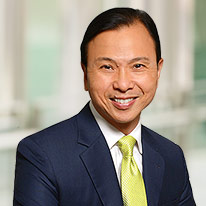
StarHub chief executive officer Tan Tong Hai is stepping down from Singapore’s number two telecom operator in May 2018, amid fierce competition in the sector.
Announcing the change today, the company said it had begun looking for a new head honcho to replace the veteran in the industry.
Talk of a change has been in the grapevine for a while, though the announcement that Tan would stay for another six months might surprise some.
In a company statement, he said he would be working with the board in its global search for his replacement. Now was the time to step down to pursue his own interests, he added.
The 54-year-old first joined StarHub in 1999 to head up StarHub Internet. He then left to helm rival Pacific Internet and systems integrator Singapore Computer Systems, before returning to StarHub as chief operating officer in January 2009.
In 2013, he was promoted to CEO, taking over from Neil Montefiore, himself a former CEO of rival M1.
Tan is known for his energetic and informal style, often taking a hands-on approach to problems. In Pacific Internet, he vacated his private office and sat among other staff, in an arrangement popular during the dot.com era.
In StarHub, he faced larger challenges, as the market for consumer infocomm services became saturated. Singapore’s nationwide fibre broadband network, rolled out in 2009, brought new players into the market and made its cable network less attractive.
Under his leadership, StarHub grew its enterprise business to more than S$900 million, in a pivot away from its traditional consumer revenue sources. It also launched its Cyber Security Centre of Excellence in the same year.
However, his impending departure comes amid the fiercest competition in years in the telecom sector. Without its traditional monopoly in pay-TV programmes and facing competition in both broadband and mobile services, StarHub will have to face up to a more dominant Singtel and smaller, more fleet-footed rivals.
Its latest results announced earlier this month reflect the challenging situation it is in. Net profit after tax for the quarter ended in September 2017 was down 11 per cent year-on-year. The performance for the year to date fell 18 per cent from a year ago.
Mobile services, which contribute about half of its revenue, brought in less, as did pay-TV and broadband services. On the bright side, enterprise fixed services, which are now the second largest contributor to its revenue, are growing.
The challenge at StarHub is not unique. Earlier this year, rival M1’s major shareholders were said to be on the lookout for buyers, as the entrance of a fourth telco next year is expected to drive up competition and force existing players to cut prices and lower profits to stay in the game.
The biggest winner despite the tough competition seems to be Singtel. With deeper pockets, infrastructure assets and regional businesses to broaden its reach, it has been less affected by the intense price cutting in its home market.
Indeed, the biggest telco in town is looking the strongest to weather the choppy waters next year, as M1 seems uncertain of a new buyer and StarHub looks for a new leader.






